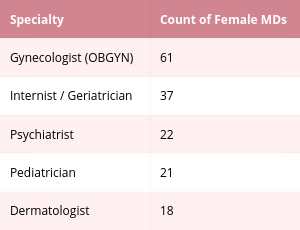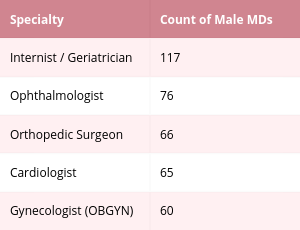Data Scraping Ratemds.com - A Closer Look at NYC's Doctors
The skills the author demoed here can be learned through taking Data Science with Machine Learning bootcamp with NYC Data Science Academy.
Introduction
About RateMDs
Ratemds.com is an extensive online resource that aims to provide potential patients with valuable information on healthcare providers and facilities across the United States. The site houses data and information on over 1.7 million healthcare providers, as well as over 2.6 million ratings and reviews pertaining to said doctors. Although RateMDs is not the only site of its kind, it is unique in its claim to be patient-centric, operating “by patients, for patients.”
Anyone can post a review about a doctor or healthcare facility on the site, and even create a new listing for a provider or facility that has not yet been rated. Many providers, realizing the profound impact that word-of-mouth recommendations have on business, ultimately claim their profiles on the site to provide more specific and accurate information about themselves and their practices. Providers also use these profiles as a tool to monitor and assess patient satisfaction, as well as to respond directly to praise or concerns raised within individual patient reviews.
How does the RateMDs rating/review process work?
The site allows patients to post ratings and reviews for doctors across all medical specialties. Reviewers rate doctors based on four criteria: their staff, punctuality, helpfulness and knowledge. Reviewers also have the option to provide comments to explain why they assigned a particular score. While the site does reserve the right to remove comments or entire ratings deemed inappropriate, patients are encouraged to post written feedback relating either to their personal outcome of care or any customer service-related issues encountered.
Taking measures to protect both reviewers and listed MDs, the site employs both automated algorithms and human moderators to filter out fake reviews. Fake reviews include those posted by reviewers who have not actually visited a doctor they are reviewing, as well as those posted multiple times by a single reviewer in an attempt to slander or show exaggerated praise for a physician or facility.
Data Scraping RateMDs
Using the Scrapy package for Python, I created two spiders to extract information on MDs listed in New York City. After completing the scraping process, I was left with two datasets: one containing general information on NYC doctors and the other containing a set of reviews pertaining to each of those doctors. I scraped 1,388 MDs and 36,399 reviews from the site. The variables collected include: name, gender, specialty, location of practice (by borough), number of reviews, languages spoken, insurances accepted and ratings.
Data Findings
In a city as diverse as NYC, how many doctors accommodate multi-lingual populations by speaking more than one language? What are the most commonly spoken languages by NYC MDs?
According to the New York City government, as of 2014 about 48.9% of the population in NYC above the age of five spoke a language other than English at home. Of that 48.9%, about 49.8% spoke Spanish, 12.3% spoke Chinese and 4.8% spoke Russian. The percentage of NYC residents who speak a language other than English as well as the range of languages spoken speak to the city’s famous diversity.
I was surprised to find that the vast majority of doctors listed on RateMDs did not include information on any languages spoken. Out of the 1,388 doctors scraped, this information was only available for 361. Using the 361 valid observations, I created a histogram displaying the distribution of doctors speaking more than one language, as well as a table depicting the top five languages listed on doctor profiles.
Across the United States, 34% of Physicians are women and 66% are men. How did the RateMDs gender ratio compare?
New York is one of the leading states in terms of its proportion of female MDs. As of 2017, about 38% of MDs in New York State were female and 62% were men.¹ Taking this into account, it was not surprising to find that the ratio of female to male doctors scraped from RateMDs was about 23% to 77%. It is unclear whether the exaggerated disparity was observed because there are in fact fewer female doctors in NYC or whether female doctors have been reviewed less frequently on this site.
The two graphs below depict the ratio of female to male doctors scraped from RateMDs as well as the gender ratio within the range of specialties scraped from each profile. In all, 325 female MDs and 1064 male MDs were scraped from the website. Internists/Geriatricians appear to have the most listings on the site. Of the 154 Internists/Geriatricians collected, 117 were male and 37 were female.
The top five specialties for female and male doctors scraped off of RateMDs are shown in the tables below. While gynecology was found to be the most popular specialty among female doctors in the NYC area, there was an almost equal number of male gynecologists found on the site. The most commonly listed specialty for male doctors, Internists/Geriatrician, came in second for female doctors.
What are the most widely accepted health insurances by NYC doctors?
As of 2016 in New York state, only about 6% of the population was uninsured. To put this figure into perspective, Texas had the largest percentage of uninsured residents at 15%. While there is a small portion of the NY population that is not able to access health insurance, about 50% of the population does have access and gains this access through their employers.² Taking this into account, it was no surprise to find that Blue Cross / Blue Shield was the most widely accepted insurance among RateMDs doctors in NYC. It is likely that the top five accepted insurances depicted below are offered to New Yorkers through their employers.
The presence of Medicare as opposed to Medicaid within the top five was interesting to see as there is a larger number of Medicaid users in New York state than there are Medicare users. About 24% of NY's population qualify for Medicaid, while only about 13% use Medicare. It is unclear as to whether this observation is a reflection of the Medicaid versus Medicare using populations in NYC, or if there is some other factor influencing the results below.
How well are NYC MDs performing according to their patients?

- Distribution of Physicians by Gender. (2017, May 01). Retrieved October 30, 2017, from https://www.kff.org/other/state-indicator/physicians-by-gender/?currentTimeframe=0&sortModel=%7B%22colId%22%3A%22Location%22%2C%22sort%22%3A%22asc%22%7D
- Health Insurance Coverage of the Total Population. (2017, September 19). Retrieved October 30, 2017, from https://www.kff.org/other/state-indicator/total-population/?currentTimeframe=0&sortModel=%7B%22colId%22%3A%22Location%22%2C%22sort%22%3A%22asc%22%7D








